Image Classification with CNNs
Today we are going to discuss a bit of convolutional neural network (CNN,) and we perform a Classification by using Keras and Tensorflow like backend.
Introduction
CNNs are regularized versions of multilayer perceptrons, that usually mean fully connected networks, that is, each neuron in one layer is connected to all neurons in the next layer.
The “fully-connectedness” of these networks makes them prone to overfitting data.
Typical ways of regularization include adding some form of magnitude measurement of weights to the loss function.
CNNs take a different approach towards regularization: they take advantage of the hierarchical pattern in data and assemble more complex patterns using smaller and simpler patterns.
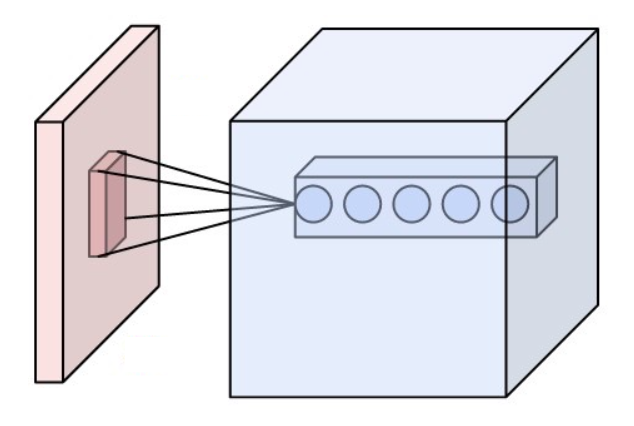
Neurons of a convolutional layer (blue), connected to their receptive field (red)
Convolutional layer
The convolutional layer is the core building block of a CNN. The layer’s parameters consist of a set of learnable filters, which have a small receptive field, but extend through the full depth of the input volume.
During the forward pass, each filter is convolved across the width and height of the input volume, computing the dot product between the entries of the filter and the input and producing a 2-dimensional activation map of that filter.
As a result, the network learns filters that activate when it detects some specific type of feature at some spatial position in the input.
Stacking the activation maps for all filters along the depth dimension forms the full output volume of the convolution layer.
Every entry in the output volume can thus also be interpreted as an output of a neuron that looks at a small region in the input and shares parameters with neurons in the same activation map.
Local connectivity

Typical CNN architecture
When dealing with high-dimensional inputs such as images, it is impractical to connect neurons to all neurons in the previous volume because such a network architecture does not take the spatial structure of the data into account.
Convolutional networks exploit spatially local correlation by enforcing a sparse local connectivity pattern between neurons of adjacent layers: each neuron is connected to only a small region of the input volume.
Lets see an example , we us CNN to classify images by using Keras, We will take the CIFAR-10 dataset that consists of 60000 32x32 colour images in 10 classes, with 6000 images per class. There are 50000 training images and 10000 test images.
Import Libraries
import tensorflow as tf
import os
import numpy as np
from matplotlib import pyplot as plt
%matplotlib inline
if not os.path.isdir('models'):
os.mkdir('models')
print('TensorFlow version:', tf.__version__)
print('Is using GPU?', tf.test.is_gpu_available())
TensorFlow version: 2.3.0
Preprocess Data
def get_three_classes(x, y):
indices_0, _ = np.where(y == 0.)
indices_1, _ = np.where(y == 1.)
indices_2, _ = np.where(y == 2.)
indices = np.concatenate([indices_0, indices_1, indices_2], axis=0)
x = x[indices]
y = y[indices]
count = x.shape[0]
indices = np.random.choice(range(count), count, replace=False)
x = x[indices]
y = y[indices]
y = tf.keras.utils.to_categorical(y)
return x, y
(x_train, y_train), (x_test, y_test) = tf.keras.datasets.cifar10.load_data()
x_train, y_train = get_three_classes(x_train, y_train)
x_test, y_test = get_three_classes(x_test, y_test)
print(x_train.shape, y_train.shape)
print(x_test.shape, y_test.shape)
(15000, 32, 32, 3) (15000, 3)
(3000, 32, 32, 3) (3000, 3)
There are 15000 examples in the training set and 3000 in the test set, there are 3 channels and each picture has a size of 32 times 32 pixels
Visualize Examples
class_names = ['aeroplane', 'car', 'bird']
def show_random_examples(x,y,p):
indices = np.random.choice(range(x.shape[0]),10, replace=False)
x = x[indices]
y = y[indices]
p = p[indices]
plt.figure(figsize=(10,5))
for i in range(10):
plt.subplot(2,5,1+i)
plt.imshow(x[i])
plt.xticks([])
plt.xticks([])
col = 'green' if np.argmax(y[i]) == np.argmax(p[i]) else 'red'
plt.xlabel(class_names[np.argmax(p[i])], color=col)
plt.show()
show_random_examples(x_train, y_train, y_train)
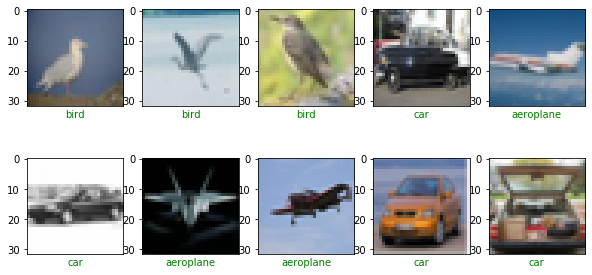
show_random_examples(x_test, y_test, y_test)
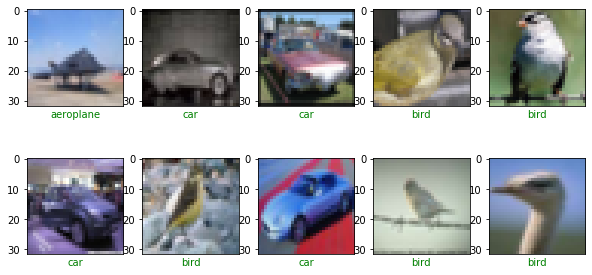
Create Model
from tensorflow.keras.layers import Conv2D, MaxPooling2D, BatchNormalization
from tensorflow.keras.layers import Dropout, Flatten, Input, Dense
def create_model():
def add_conv_block(model, num_filters):
model.add(Conv2D(num_filters,3, activation = 'relu', padding = 'same'))#convolution layers
model.add(BatchNormalization())#Regularization , assures low variance of the previous layes
model.add(Conv2D(num_filters,3,activation='relu'))# another filter,
model.add(MaxPooling2D(pool_size=2))#reduce the rows and columns half of the original value
model.add(Dropout(0.5))
return model
model = tf.keras.models.Sequential()
model.add(Input(shape=(32,32,3)))
model = add_conv_block(model, 32)
model = add_conv_block(model,64)
model = add_conv_block(model, 128)
model.add(Flatten())
model.add(Dense(3,activation='softmax'))
model.compile(
loss='categorical_crossentropy',
optimizer ='adam', metrics=['accuracy']
)
return model
model = create_model()
model.summary()
Model: "sequential_1"
_________________________________________________________________
Layer (type) Output Shape Param #
=================================================================
conv2d_6 (Conv2D) (None, 32, 32, 32) 896
_________________________________________________________________
batch_normalization_3 (Batch (None, 32, 32, 32) 128
_________________________________________________________________
conv2d_7 (Conv2D) (None, 30, 30, 32) 9248
_________________________________________________________________
max_pooling2d_3 (MaxPooling2 (None, 15, 15, 32) 0
_________________________________________________________________
dropout_3 (Dropout) (None, 15, 15, 32) 0
_________________________________________________________________
conv2d_8 (Conv2D) (None, 15, 15, 64) 18496
_________________________________________________________________
batch_normalization_4 (Batch (None, 15, 15, 64) 256
_________________________________________________________________
conv2d_9 (Conv2D) (None, 13, 13, 64) 36928
_________________________________________________________________
max_pooling2d_4 (MaxPooling2 (None, 6, 6, 64) 0
_________________________________________________________________
dropout_4 (Dropout) (None, 6, 6, 64) 0
_________________________________________________________________
conv2d_10 (Conv2D) (None, 6, 6, 128) 73856
_________________________________________________________________
batch_normalization_5 (Batch (None, 6, 6, 128) 512
_________________________________________________________________
conv2d_11 (Conv2D) (None, 4, 4, 128) 147584
_________________________________________________________________
max_pooling2d_5 (MaxPooling2 (None, 2, 2, 128) 0
_________________________________________________________________
dropout_5 (Dropout) (None, 2, 2, 128) 0
_________________________________________________________________
flatten_1 (Flatten) (None, 512) 0
_________________________________________________________________
dense_1 (Dense) (None, 3) 1539
=================================================================
Total params: 289,443
Trainable params: 288,995
Non-trainable params: 448
_________________________________________________________________
Train the Model
h = model.fit(
x_train/255., y_train,
validation_data=(x_test/255., y_test),
epochs=10, batch_size=128,
callbacks=[
tf.keras.callbacks.EarlyStopping(monitor='val_accuracy', patience =3),
tf.keras.callbacks.ModelCheckpoint(
'models/model_{val_accuracy:.3f}.h5',
save_best_only=True, save_weights_only=False,
monitor='val_accuracy'
)
]
)
Train on 15000 samples, validate on 3000 samples
Epoch 1/10
15000/15000 [==============================] - 137s 9ms/sample - loss: 0.8714 - accuracy: 0.6817 - val_loss: 3.1173 - val_accuracy: 0.3333
Epoch 2/10
15000/15000 [==============================] - 131s 9ms/sample - loss: 0.5483 - accuracy: 0.7750 - val_loss: 2.2622 - val_accuracy: 0.3550
Epoch 3/10
15000/15000 [==============================] - 131s 9ms/sample - loss: 0.4840 - accuracy: 0.8077 - val_loss: 1.7752 - val_accuracy: 0.5373
Epoch 4/10
15000/15000 [==============================] - 131s 9ms/sample - loss: 0.4407 - accuracy: 0.8277 - val_loss: 1.2938 - val_accuracy: 0.5650
Epoch 5/10
15000/15000 [==============================] - 134s 9ms/sample - loss: 0.4049 - accuracy: 0.8387 - val_loss: 0.8936 - val_accuracy: 0.6917
Epoch 6/10
15000/15000 [==============================] - 134s 9ms/sample - loss: 0.3730 - accuracy: 0.8553 - val_loss: 0.7478 - val_accuracy: 0.7560
Epoch 7/10
15000/15000 [==============================] - 133s 9ms/sample - loss: 0.3395 - accuracy: 0.8689 - val_loss: 0.3435 - val_accuracy: 0.8683
Epoch 8/10
15000/15000 [==============================] - 136s 9ms/sample - loss: 0.3149 - accuracy: 0.8773 - val_loss: 0.3093 - val_accuracy: 0.8830
Epoch 9/10
15000/15000 [==============================] - 136s 9ms/sample - loss: 0.2983 - accuracy: 0.8821 - val_loss: 0.3287 - val_accuracy: 0.8690
Epoch 10/10
15000/15000 [==============================] - 136s 9ms/sample - loss: 0.2788 - accuracy: 0.8930 - val_loss: 0.6321 - val_accuracy: 0.8080
Final Predictions
accs = h.history['accuracy']
val_accs = h.history['val_accuracy']
plt.plot(range(len(accs)), accs, label='Training')
plt.plot(range(len(accs)),val_accs, label='Validation')
plt.legend()
plt.show()
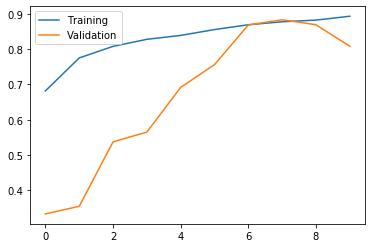
model = tf.keras.models.load_model('models/model_0.883.h5')
preds = model.predict(x_test/255.)
show_random_examples(x_test,y_test,preds)
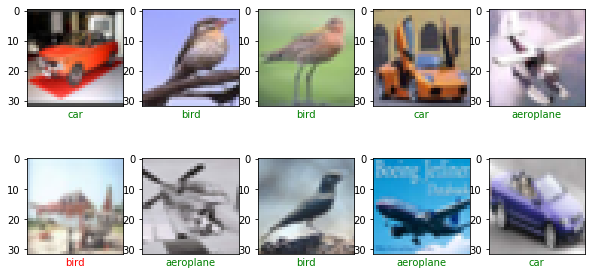
Congratulations! We have applied Neural Networks in Tensorflow with CNN to classify images.

Leave a comment